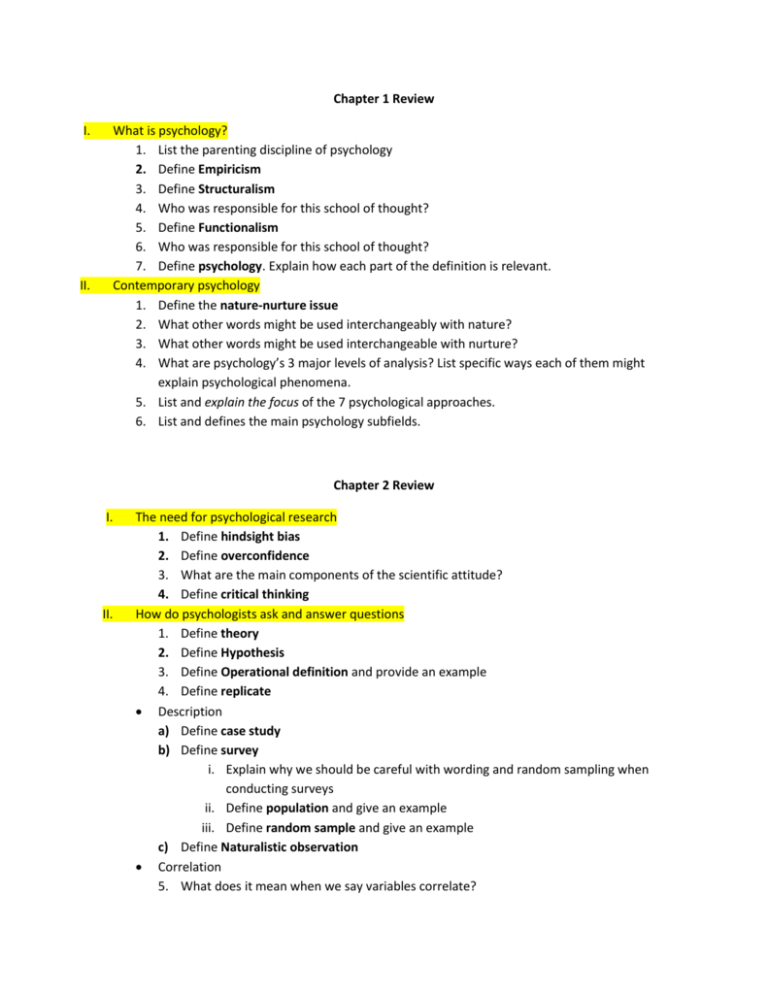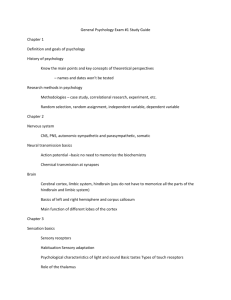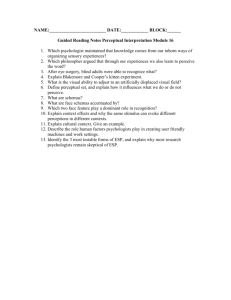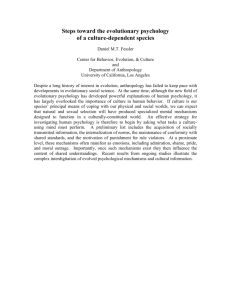AP Review - Mater Academy Lakes High School
advertisement

Chapter 1 Review I. II. What is psychology? 1. List the parenting discipline of psychology 2. Define Empiricism 3. Define Structuralism 4. Who was responsible for this school of thought? 5. Define Functionalism 6. Who was responsible for this school of thought? 7. Define psychology. Explain how each part of the definition is relevant. Contemporary psychology 1. Define the nature-nurture issue 2. What other words might be used interchangeably with nature? 3. What other words might be used interchangeable with nurture? 4. What are psychology’s 3 major levels of analysis? List specific ways each of them might explain psychological phenomena. 5. List and explain the focus of the 7 psychological approaches. 6. List and defines the main psychology subfields. Chapter 2 Review I. II. The need for psychological research 1. Define hindsight bias 2. Define overconfidence 3. What are the main components of the scientific attitude? 4. Define critical thinking How do psychologists ask and answer questions 1. Define theory 2. Define Hypothesis 3. Define Operational definition and provide an example 4. Define replicate Description a) Define case study b) Define survey i. Explain why we should be careful with wording and random sampling when conducting surveys ii. Define population and give an example iii. Define random sample and give an example c) Define Naturalistic observation Correlation 5. What does it mean when we say variables correlate? III. IV. 6. Define correlation coefficient 7. Define Scatterplots 8. Draw three graph each depicting a perfect positive correlation (+1.00), on depicting a perfect negative correlation (-1.00) and one depicting not correlation at all (0). 9. How are correlation and causation related? 10. Define and give an example of an illusory correlation. Experimentation 11. What is the unique feature of experiments? What does it allow you to do that other research methods don’t? How is that accomplished? 12. Define random assignment. 13. Define double-bind procedure. 14. What is the placebo effect? How is it related to double blind procedure? 15. What is the difference between the experimental and control group? 16. What are the dependent and independent variables? How are they related? Give an example. 17. Define confounding variables. Give an example. 18. What is the difference between validity and reliability? Give an example. 19. Replicate Table 2.3 on p. 36: Comparing Research Methods Statistical Reasoning in Everyday Life Describing Data 1. State and define the 3 measures of central tendency. 2. Using this data set of students’ GPA, calculate each. 3.3, 4.1, 5.4, 2.1, 1, .99, 2.4, 3.0, 2.1, 2.2. 3. What is the meaning of a “skewed” distribution? How does it affect the measures of central tendency? 4. Draw a positively and negative skewed distribution. 5. State and define two measures of Variation 6. Using this set of data, find the standard deviation: 5, 4, 3, 6, 6, 6, 7, 5, 8. 7. What is and what is the significance of the normal curve? 8. Draw the normal curve, label and identify all its parts (breakdowns). Making Inferences 9. List three indicators that help us considered observed differences as reliable. 10. What is statistical significance? Give an example. Ethics in research Research on Animals 1. Summarize the different points of view on animal research. Research on People 2. List the ethical principles developed by the APA. 3. What is the APA? 4. Define Informed consent. 5. Define Debrief Chapter 3A Review Neural Communication 1. 2. 3. 4. 5. 6. 7. 8. 9. 10. 11. 12. 13. Who are biological psychologists? Draw a typical neuron. Label each part and state its functions. What are the three types of neurons? How do they different? Define action potential. What do we mean when we say that a neuron is polarized? When does it de-polarize? What is the resting potential? What is the threshold and how is it related to excitatory and inhibitory signals? Summarize how neurons communicate. Make sure to include key terms such as synapse, neurotransmitters and reuptake in your description. Draw a picture of neural communication (the process described in the above question). Replicate Tabel 3A.1 on p. 57 How do drugs and other chemicals alter neurotransmission? Define and give examples of what is an agonist and an antagonist. The Nervous System 1. 2. 3. 4. Sketch the divisions of the nervous system. Define each division. Explain what the relationship between the sympathetic is and parasympathetic nervous system. What is a reflex? Explain how reflexes happen. Make sure to state the relationship between interneuron, motor (efferent) and sensory (afferent) neurons. 5. Draw and label the process described above. The endocrine system 1. Define the endocrine system. 2. Define hormones. How are hormones similar and different to neurotransmitters? 3. What is the pituitary gland? What is its nickname? Chapter 3B Review Tools of discovering the brain 1. Define lesion. Give an example of how it can be used to understand behavior. 2. Define EEG. How does the word help you remember its use? 3. Define the neuroimaging techniques such as MRI, fMRI, CT and PET scans. Older Brain Structures 1. Draw and label the components of the brainstem (pons and medulla), thalamus and reticular formation. Draw icons/symbols that would help you remember its functions. 2. What is the cerebellum? What are some of its functions? 3. Draw and label the components of the Limbic System. Draw icons/symbols that would help you remember their functions. The Cerebral Cortex 1. Define glial cells. 2. Draw the lobes of the brain, label them and state (or create symbols/icons) their primary functions. 3. What is and where (which lobe) is the motor cortex located? 4. Explain how they mapped it. 5. What is and where (which lobe) is the sensory cortex located? 6. What are the association areas of the brain? 7. How the case of Phineas Gage did helped us understand the role of the frontal lobe? 8. State the primary responsibility and location of Wenicke’s area, angular gyrus, and Broca’s area. 9. What is brain Plasticity? 10. Define neurogenesis. Our Divided Brain 1. 2. 3. 4. Define split brain. What is the corpus callosum? What is hemispheric specialization? What have we learn about the roles of the left and right hemisphere as a result of studying split brain patients. 5. What hemisphere specializes in recognizing faces, perceptual tasks, processing language? The Brain and Consciousness 1. 2. 3. 4. 5. Define consciousness. Define cognitive neuroscience. Define dual processing. Explain how research on priming helps us understand dual processing. Summarize the research on the “two-track” mind. Chapter 3C Behavior Genetics 1. What are genes, and how do behavior geneticist explain our individual differences? 2. Summarize the findings on Twin and adoption studies. 3. What is the difference between fraternal and identical twins? Why are they used to determine nature vs. nurture issues? 4. Summarize the main finding of studies on separated twins. 5. Summarize the main findings of biological vs. adoptive relatives. 6. What is heritability, and how does it relate to individuals and groups. Evolutionary Psychology 1. How do evolutionary psychologist use natural selection to explain behavior tendencies? 2. How does evolutionary success help explain similarities? 3. How might an evolutionary psychologists explain gender differences in sexuality and mating preferences? 4. List 3 criticisms of evolutionary theory. Reflections on nature and nurture. 1. How does the biopsychosocial approach explain our individual development? Chapter 4 Sensing the world 2. 3. 4. 5. 6. 7. 8. 9. 10. 11. 12. 13. What is the difference between sensation and perception? What do we mean by bottom-up processing and top-down processing? What is and how are we affected by selective attention? What is the cocktail party effect? How can accidents be influenced by selective attention? What is intentional blindness? What is change blindness? What is choice blindness? What is the difference between absolute threshold and difference threshold? Does stimuli below the absolute threshold have any influence? What is signal detection theory? What do we mean when we say something is subliminal? How is it related to “primng”. 14. What is Weber’s law? 15. What is the function of sensory adaptation? Vision 1. 2. 3. 4. 5. 6. 7. 8. What is the energy that we see as visible light? Draw and define wavelength, hue and intensity. Explain how they are related. How does the eye transform light energy into neural messages? Draw and label and define: iris, pupil, lens, retina, accommodation, blind spot, fovea, cones, and optic nerve. How does the brain process visual information? Explain parallel processing. Explain the Young-Helmholtz trichromatic (three-color) theory. Explain the opponent-process theory. Hearing 1. 2. 3. 4. 5. 6. 7. 8. What are the characteristics of air pressure waves that we hear as sound? How does the ear transform sound energy into neural messages? Draw, label and define middle ear, cochlea, and inner ear. What is the “auditory cortex”? Explain how we perceive loudness. Explain the “place theory” and the “frequency theory” of pitch perception. How do we locate sound? What are the common causes of hearing loss, and why does controversy surround cochlear implants? Other Senses 1. 2. 3. 4. 5. 6. 7. 8. 9. How do we sense touch? How do we sense our body’s position and movement? How do we experience pain? What are the 4 basic skin sensation? How do we perceive other skin sensations? Explain kinesthesis. Explain vestibular sense Describe the gate-control theory of pain. Summarize the psychological and social-cultural influences on pain. How can we control pain? Taste 1. How do we experience taste? 2. What is sensory interaction? Smell 1. How do we experience smell? Perceptual Organization 2. 3. 4. 5. 6. 7. 8. 9. 10. 11. How did the Gestalt psychologist understand perceptual organization? How do figure-ground and grouping principles contribute to our perceptions? Explain the grouping principles. How do we see the world in three dimensions? Define visual cliff. What are binocular cues and how is it related to retinal disparity? Define and give examples of monocular cues. How do we perceive motion? What is the phi phenomenon? Give an example. How do perceptual constancies help us organize our sensations into meaningful perceptions? Perceptual interpretation 1. What does research on sensory deprivation and restored vision reveal about the effects of experience on perception? 2. How adaptable is our ability to perceive? 3. How do our expectations, contexts, and emotions influence our perception? 4. What is a perceptual set? Extrasensory Perception 1. What are the claims of ESP, and what have most research psychologists concluded after putting these claims to the test?





